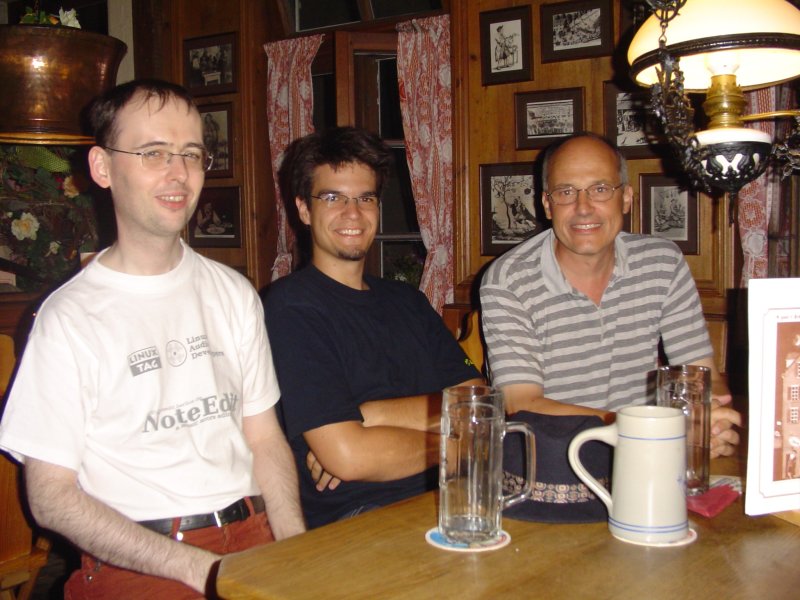-
Notifications
You must be signed in to change notification settings - Fork 14
About Canorus
Canorus is a free next generation cross-platform music score editor.
 Canorus could be called the sequel of NoteEdit, a well-known KDE music score editor. NoteEdit was the child of one man (dr. Jörg Anders from University in Chemnitz, Germany). Mr. Anders put a great effort into the project and NoteEdit is still one of the most usable music score editors available for Linux. However, in August 2004, Mr. Anders dropped NoteEdit due to some unknown, or rather, poorly-understood reasons (see here). The last officially released version was NoteEdit v2.7.3.
Canorus could be called the sequel of NoteEdit, a well-known KDE music score editor. NoteEdit was the child of one man (dr. Jörg Anders from University in Chemnitz, Germany). Mr. Anders put a great effort into the project and NoteEdit is still one of the most usable music score editors available for Linux. However, in August 2004, Mr. Anders dropped NoteEdit due to some unknown, or rather, poorly-understood reasons (see here). The last officially released version was NoteEdit v2.7.3.
A couple of months later, a new development team was formed and a fresh wind blew. The development team consisted of:
- Reinhard Katzmann aka @suamor (project leader)
- Matevž Jekovec aka @matevz (developer, composer)
- Georg Rudolph aka @itsgeorg (LilyPond meister)
- Leon Vinken (MusicXML meister)
Canorus was founded by a long-time NoteEdit users and later developers, Matevž "ThePianoGuy" Jekovec from Slovenia and Reinhard "Suamor" Katzmann from Germany in March, 2006. Shortly, more developers joined working on MIDI import, MusicXML, inline python console, packaging, translations, and bug fixes. Read the AUTHORS file for a complete list. While development pace varies, most of development is done around the Linux audio conference where developers meet in person.
Canorus is a Latin word meaning sweet, rich, deep, warm, friendly, and full of gentle sound and harmony. This is exactly what Canorus should present: A friendly user interface, deep and strong fundamentals, a warm welcome to newcomers and a rich set of features. Canorus was named by its founders, Matevž and Reinhard.
See http://www.archives.nd.edu/cgi-bin/lookup.pl?stem=canorus&ending= for technical description of the word :)
 Canorus should introduce breakthrough features for a music score editor application like a scripting language support, plugins subsystem (plugins written in Python and Ruby or natively compiled library) - similar to extensions in Mozilla Firefox, open XML-based score file format, similar score structures to Lilypond in order to achieve better interoperability, source view of the score with a real-time parser, multiple viewports on the same music score and more (experimental features like 3D score view?)!
Canorus should introduce breakthrough features for a music score editor application like a scripting language support, plugins subsystem (plugins written in Python and Ruby or natively compiled library) - similar to extensions in Mozilla Firefox, open XML-based score file format, similar score structures to Lilypond in order to achieve better interoperability, source view of the score with a real-time parser, multiple viewports on the same music score and more (experimental features like 3D score view?)!
It should introduce a new way of music representation and a brand new user interface for a composer (unfortunately, many composers still use pencil&paper, because it provides the flexibility and liberty they need).
Simply: Because we don't need another commercial-bloaty music score editor which dies in a few years and is not compatible with its competitors. Sounds familiar? Actually, things are a bit more complex :)
Canorus was started with openess in mind. We wanted to create a new interface to music composition. This was experimental and no one would pay us for just experimenting and searching around. Another feature was cross-platformability (Linux users were desperate to have a music score editor, NoteEdit was there, but it was dead) - Linux environment is, by nature, free software. We needed a project that opened its API to 3rd party developers, who would be able to easily write extensions. This was most easily achievable by making the whole project open. And most of all, we wanted to spread Canorus around the globe to as many people as possible. One of the ways to do this was to offer Canorus at no charge.
As you could see, all of the above mentioned goals were achievable by making Canorus free software. We never regret it.

Canorus developers meeting, Tübingen, Germany, July 2006. From left: Reinhard Katzmann (@suamor), Matevž Jekovec (@matevz), Georg Rudolph (@itsgeorg)